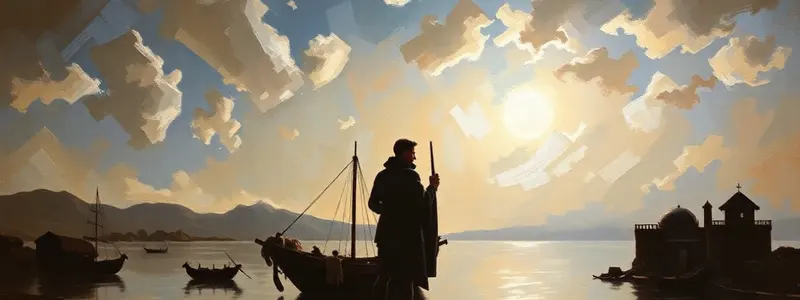Podcast
Questions and Answers
What does the term 'Geschichte' mean in German?
What does the term 'Geschichte' mean in German?
- A systematic account
- A written history
- That which has happened (correct)
- An oral tradition
Which of the following best describes primary sources?
Which of the following best describes primary sources?
- They are firsthand accounts or evidence from the time being studied. (correct)
- They are secondary analyses of primary data.
- They include artifacts and oral histories.
- They are interpretations of historical events.
What is the role of external criticism in historical research?
What is the role of external criticism in historical research?
- To create a narrative from primary sources.
- To determine the authenticity of a source. (correct)
- To analyze the credibility of the author's perspective.
- To establish the interpretation of the sources.
Who was Dr. Robert Fox?
Who was Dr. Robert Fox?
What are the three castes according to 'Custom of Tagalog'?
What are the three castes according to 'Custom of Tagalog'?
What does 'verisimilar' refer to in historical methodology?
What does 'verisimilar' refer to in historical methodology?
What was the primary purpose of the National Historical Commission of the Philippines?
What was the primary purpose of the National Historical Commission of the Philippines?
What are dowries in the context of the Custom of Tagalog?
What are dowries in the context of the Custom of Tagalog?
What was Apolinario Mabini known as during the Philippine Revolution?
What was Apolinario Mabini known as during the Philippine Revolution?
Which event marked the start of hostilities leading to the Philippine-American War?
Which event marked the start of hostilities leading to the Philippine-American War?
What significant role did Mabini fulfill in the First Philippine Republic?
What significant role did Mabini fulfill in the First Philippine Republic?
Which of the following was NOT a character mentioned in the context provided?
Which of the following was NOT a character mentioned in the context provided?
Who was the revolutionary leader that Mabini advised?
Who was the revolutionary leader that Mabini advised?
What supernatural ability did the Mangagayoma possess?
What supernatural ability did the Mangagayoma possess?
What was the consequence for a woman who died in childbirth according to the belief in Patianac?
What was the consequence for a woman who died in childbirth according to the belief in Patianac?
Which of the following describes the MANCocolam?
Which of the following describes the MANCocolam?
Flashcards are hidden until you start studying
Study Notes
Understanding History
- History is seen as a systematic account of natural phenomena, according to Aristotle.
- "Geschichte" is the German term for history, meaning "that which has happened."
Types of Historical Sources
- Written Sources: Includes published materials.
- Manuscript Sources: Archival materials and memoirs.
- Non-Written Sources: Encompasses oral history and artifacts.
Classification by Origin
- Primary Sources: Firsthand accounts from eyewitnesses.
- Secondary Sources: Analyze and interpret primary sources.
Archaeological Findings
- Tabon Man: Skullcap dated back to 14,500 BC and three jaw bones to 29,000 BC found in Palawan's west coast.
Notable Historians
- Dr. Robert Fox: American archaeologist and historian focused on pre-Hispanic Philippines.
- William Henry Scott (1921-1993): Historian of the Gran Cordillera Central and pre-Hispanic Philippines.
Historical Methods
- Verification of sources is crucial for historians.
- Historical Criticism: Analyzes form and content of sources.
- External Criticism: Assesses authenticity, identifying hoaxes and forgeries through tests of date, authorship, and semantics.
- Internal Criticism: Evaluates credibility based on the author's character and corroboration of facts.
Archival Institutions and Resources
- National Archives of the Philippines: Preserves primary sources.
- National Historical Commission of the Philippines: Focuses on culture and development agendas.
- National Museum of the Philippines: Houses various primary source repositories.
- PARES: Spanish documentary archive established by the Ministry of Education in 2007.
Cultural Practices among Tagalogs
- Datos: Chief and head of Barangay; family structure includes relations and slaves.
- Three Castes:
- Nobles (Maharlica): Freeborn individuals.
- Commoners (Aliping Namamahay): Semi-free individuals.
- Slaves (Aliping Saguiguilid): Bonded individuals.
Folklore and Mythical Figures
- Various supernatural entities and practices such as CATOLONAN (poetic priests), MANGAGAUAY (deceitful healers), and OSUANG (man-eating sorcerers).
Historical Misconceptions
- Filipinos are mistakenly labeled as "mangmang" (ignorant); this challenges colonial narratives.
The Philippine Revolution (1896)
- Apolinario Mabini, known as "Utak ng Himagsikan," played a pivotal role as chief advisor to Emilio Aguinaldo.
- Formulated decrees for the First Philippine Republic and helped draft its constitution.
- Appointed Prime Minister on January 2, 1899, but resigned on May 7, 1899.
Key Events Leading to Independence
- December 30, 1896: Execution of José Rizal.
- May 1898: Destruction of the Spanish fleet.
- June 12, 1898: Mabini queries Aguinaldo about agreements with the US.
- February 4, 1899: Outbreak of hostilities between American forces and Filipino revolutionaries.
Political Developments
- Mabini's engagement with the US government prior to constitution proposals highlighted the transitional period towards Philippine independence.
Studying That Suits You
Use AI to generate personalized quizzes and flashcards to suit your learning preferences.




